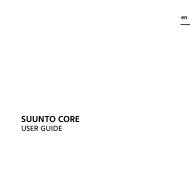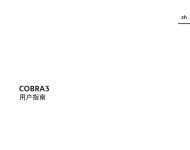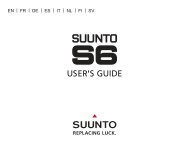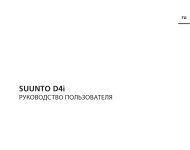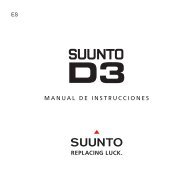Suunto Fused™ RGBM
Suunto Fused™ RGBM
Suunto Fused™ RGBM
- No tags were found...
You also want an ePaper? Increase the reach of your titles
YUMPU automatically turns print PDFs into web optimized ePapers that Google loves.
THE PATH TO FUSED <strong>RGBM</strong>At the heart of every <strong>Suunto</strong> dive computeris an algorithm that calculatesdecompression for a dive, called the reducedgradient bubble model (<strong>RGBM</strong>).Relentlessly pursuing ever safer modelsfor divers of all types, <strong>Suunto</strong> continuesto push for <strong>RGBM</strong> perfection. A storiedhistory full of science, development,and underwater experience lies withinevery <strong>Suunto</strong> dive computer.This document explains detailes of ouralgorithm, and how the new <strong>Suunto</strong>Fused TM <strong>RGBM</strong> has been developed.<strong>Suunto</strong>'s work on decompressionmodels for dive computers spans overthree decades. A pioneer in the field,<strong>Suunto</strong>’s modelling has adopted thelatest scientific know-how and theoriesfrom leading experts.<strong>Suunto</strong>’s first dive computer was the<strong>Suunto</strong> SME ML (1987). Given thetechnology available at the time, itwas essentially an electronic dive table.This was obviously not adequate,and soon <strong>Suunto</strong>’s Ari Nikkola implementedthe Buhlman model for<strong>Suunto</strong> dive computers.Over the next decade, the algorithmwas further improved to increasediver safety. These include, forexample, voluntary safety stops, asymmetricon and off-gassing, as well asmodifications based on the work ofDr. Merrill P. Spencer.During this time, the dive communitywas still seeing too many accidents.To address these problems, <strong>Suunto</strong>launched the <strong>Suunto</strong> Vyper in 1999which featured the new <strong>Suunto</strong> ReducedGradient Bubble Model (<strong>RGBM</strong>).The <strong>Suunto</strong> <strong>RGBM</strong> was developed inco-operation with Dr. Bruce Wienke.The new algorithm could account fordiver behaviors which increase healthrisks. These behaviors include multidaydiving, reverse dive profiles and shortsurface intervals.When deep stops (Pyle stops) becamea proven beneficial method for decompression,they were added to the<strong>Suunto</strong> D9 and Vytec DS (2004) as avoluntary notification.With the launch of the <strong>Suunto</strong> HelO 2in 2009, <strong>Suunto</strong> introduced a newdecompression model, the <strong>Suunto</strong>Technical <strong>RGBM</strong>, also developed withDr. Wienke. This algorithm included allprevious implementations and addednew features for handling helium gas.Since the late 1980s, Dr. Wienke hadbeen working at the Los AlamosNuclear Laboratory on the so-called‘full’ <strong>RGBM</strong>. This development was targetingthe needs of deep divers andmilitary personnel carrying out difficultdives.The new <strong>Suunto</strong> Fused <strong>RGBM</strong> combinesthe benefits of <strong>Suunto</strong>’s Technical<strong>RGBM</strong> and the ‘full’ <strong>RGBM</strong>, bringingthe benefits of both to recreationaldivers and technical divers.None of this development would havebeen possible without the pioneeringwork of Dr. Wienke. Despite the rangeof dive computers offered by <strong>Suunto</strong>for most any type of diver, he hasplayed a vital role in the practical implementationof his theories.Copyright © 2012 by <strong>Suunto</strong> Oy. All rights reserved.1987<strong>Suunto</strong>’s first dive computer<strong>Suunto</strong> SME MLImplementation ofBuhlman model1999<strong>Suunto</strong> Vyper<strong>Suunto</strong> Redudec GradientBubble Model (<strong>RGBM</strong>)Developed withDr. Bruce Wienke2009<strong>Suunto</strong> HelO 2Technical <strong>RGBM</strong>Developed withDr. Bruce Wienke1990’sAlgorithm improvement: Voluntarysafety stops, asymmetric on andoff-gassingDr. Merrill P. Spencer2004<strong>Suunto</strong> D9Vytec DS2012<strong>Suunto</strong> Fused <strong>RGBM</strong>Developed withDr. Bruce Wienke<strong>Suunto</strong> has been working together with Dr. Bruce Wienke for well over a decade.Dr. Wienke is a Program Manager in the Nuclear Weapons Technology Simulation And Computing Office at the LosAlamos National Laboratory (LANL), with interests in computational decompression and models, gas transport, andphase mechanics. He is the developer of the Reduced Gradient Bubble Model (<strong>RGBM</strong>), a dual phase approach tostaging diver ascents over an extended range of diving applications (altitude, nonstop, decompression, multiday,repetitive, multilevel, mixed gas, and saturation)."<strong>RGBM</strong> is the most realistic model in science. The parameters are correlatedwith real data of thousands of dives which makes it good physics, and the datais validated and correlated. I have been working with <strong>Suunto</strong> since the 90’sand <strong>Suunto</strong>’s progression from <strong>Suunto</strong> <strong>RGBM</strong> to Technical <strong>RGBM</strong> and now to<strong>Suunto</strong> Fused <strong>RGBM</strong> is a very natural one. The new algorithmis a supermodel that covers all types of diving."- Dr. Bruce Wienke<strong>Suunto</strong> Fused <strong>RGBM</strong> www.suunto.com 2
DIvING AND YOUR BODYDiving is a great activity with thepotential for one-of-a-kind experiencesyou can only get in an aquaticenvironment. Our land-loving bodies,however, can react negatively todiving if we are not careful. Wheneveryou enter the water, be aware howyour behavior before, during andafter the dive can affect your health.Under water your body is being pushedin from all sides. This added pressurechanges how your body functions.Some of the changes you notice,like with breathing. Other changesyou may not immediately feel, but theeffects can cause serious damage toyour body, and even lead to death.The pressure change under water canaffect sensitive areas such as your earsand sinuses. Discomfort in the earswhen taking off in an airplane is alsofelt just diving down to the bottom ofa pool that is three meters deep.But the most significant impact is onyour circulatory and respiratory systems.These need to be taken seriouslyas they can lead to major healthrisks. To understand and avoid theserisks, we need to first have a look atthe world of gases.10 metersCopyright © 2012 by <strong>Suunto</strong> Oy. All rights reserved.Ambient pressureAmbient pressure increases much fasterunderwater because water is denser thanair. Ten meters down is already twice thepressure at the surface.20 metersA WORLD OF GASESIn the physical world, we are mostfamiliar with three phases of matter– gas, liquid and solid. Certain elementsand compounds are naturallyin one state or the other at a giventemperature.Typically we think of water beingmerely a liquid, but that is only truefor pure H 2O (between 0-100 C). Bothliquids and solids naturally containgas. The oxygen dissolved in water,for example, is what allows fish andother aquatic life to breathe.Our bodies are also full of dissolvedgases. Some of them, like oxygen,our bodies actively use. Other socalledinert gases like nitrogen andhelium, are not used by our bodies,but are carried in blood and tissuesnonetheless.It is these gases that can cause somuch trouble for divers. Even oxygenwhich our bodies thrive on at surfacepressures can become toxic undercertain conditions.Nitrogen and helium are the mainculprits when we look at the numberone risk divers are concerned about:decompression sickness (DCS).Gas exchange in alveoliWhen air enters the lungs, it goes througha maze of smaller and smaller tubes untilit reaches tiny sacs called alveoli. Woveninto the walls of these sacks are very fine,almost transparent, capillaries.<strong>Suunto</strong> Fused <strong>RGBM</strong> www.suunto.com 3
DECOMPRESSION SICKNESSThe amount of gases dissolved inour bodies depends on the ambientpressure around us. Each gas hasa specific partial pressure, and thecombined pressures of the gases inour bodies stays in equilibrium withour environment.Your body is fully saturated withgases at the elevation where youtypically reside. If you hike up amountain, air pressure drops, so yourbody can hold less gas. Your tissuesare at this point supersaturated relativeto the new ambient pressure. Toget back to equilibrium, our bodiesrelease gas through diffusion andbreathing. This is called off-gassing.When we go down to sea-level andthen under water, we increase thepressure on our bodies, allowingmore gas to be carried by blood andtissues. Again, to equalize the pressures,our bodies take on more dissolvedgas from the air we breathe.This is called on-gassing.If we come up from a dive too quickly(dropping ambient pressure), thenatural off-gassing mechanisms areoverloaded. Like the bubbles you seewhen you pop open that soda, thedissolved gas in our bodies comesout of solution too fast, forming bubbleswhich can ultimately cause DCS.There are different stages and formsof DCS. Symptoms can range fromminor joint pain and skin irritation tosevere nerve damage and death. Fora diver with DCS, the symptoms maycommence while still underwater, orit may take several hours after surfacing.In some cases the symptomsmay not show for several days. Mostcases are treatable with, for example,recompression chamber treatment(hyperbaric oxygen treatment).Copyright © 2012 by <strong>Suunto</strong> Oy. All rights reserved.DECOMPRESSION MODELLINGA century ago, our understanding ofDCS was fairly rudimentary and therewere no good ways to ensure diversavoid it. In the early 20 th century,work by John Scott Haldane helpedlay the foundations for future decompressionmodels which divers couldfollow to minimize risks of DCS.During a dive, tissues saturate at differentrates. This is determined by theblood flow to the tissue in question.The brain, for example, has a verygood blood supply, and is classifiedas a “fast” tissue, whilst joints havepoor blood supply and are ratedas “slow” tissue. There are severalothers in between.The length of time that it takes for atissue to reach a 50% saturation levelat a given depth is called the tissuehalftime and is usually measured inminutes. However, the saturationrate does not remain linear. A tissuereaches 50% saturation relativelyquickly. After that, the rate slows.It takes another five halftimes for agiven tissue to, theoretically, reachsaturation.%10090807060504030201000Time5 10 15 20 25 30HalftimeTissue half timeFor all practical purposes, it takes 6 halftimes for a given tissue to reach full saturation.This graph represents a 5 min tissue.<strong>Suunto</strong> Fused <strong>RGBM</strong> www.suunto.com 4
(2.5 min) Blood(10 min) Spinal cord(40 min) Skin(120 min) Muscle(480 min) JointsTissue CompartmentThe <strong>Suunto</strong> Fused <strong>RGBM</strong>divides the human body into15 theoretical tissue compartmentsaccording to the rate atwhich each tissue group on- oroff-gasses. These halftimesrange from 1 to 720 minutesCopyright © 2012 by <strong>Suunto</strong> Oy. All rights reserved.In decompression modelling, tissuesare categorized into theoretical compartmentswhich share a commonhalftime. Haldane used six compartments.The <strong>Suunto</strong> Technical <strong>RGBM</strong>uses nine compartments, and thelatest model, the Fused <strong>RGBM</strong>, uses15 compartments.It is important to understand that acompartment is not a specific tissuebut a group of tissues with theoreticalproperties. Real tissues are exceptionallycomplex and varied, making itnearly impossible to know their exactproperties.Decompression models assign eachcompartment a theoretical critical or“maximum” pressure ratio (meaningthe difference between tissue andambient pressures) above whichbubbles form. This ratio, called theM-Value, changes at depth.Haldane’s model proved to be effectiveand showed that the tissue halftimetheory was correct. His model assumedthat the mechanisms for on and offgassingwere equal. Off-gassing wasconsidered simply the reverse of ongassingand happened at the samerate. Although correct, Haldane’s decompressionmodel was incompletebecause it assumed that off-gassingonly happens via diffusion. Today'sresearch has revealed that off-gassingalso happens via perfusion.Further advances in technology allowedscientists to get a more accurateview of how gases behave in thebody. What they discovered was thatnot all gas bubbles cause DCS.<strong>Suunto</strong> Fused <strong>RGBM</strong> www.suunto.com 5
NOT ALL BUBBLES ARE EQUALWith the use of Doppler technologyand later electron microscopes, scientistsdiscovered that the body canhave “silent” bubbles that are presentthroughout blood and tissues. Theyare called silent because they do notcause DCS. Some of these are smallmicrobubbles while others are fullblown,easily detected bubbles. Andyet neither kind necessarily causesDCS symptoms.Although it is not yet clear the exactrelationship between these and DCScausingbubbles, studies have shownthat higher microbubble countsincrease the likelihood of DCS andother illnesses.What has also been established isthat once formed, these bubblesare unstable. They have an ability toattract dissolved gas from surroundingtissues and the likelihood of abubble either expanding or collapsingis determined by a range of factors.These factors include the surfacetension of the bubble, the pressurewithin the bubble and the ambientpressure relative to the bubble.A diver who completes multiple diveswithin a given day or even over anumber of days may have a build-upof silent bubbles. The accumulationof bubbles may lead to a higher riskof DCS. It is also known that microbubblescan cause longer-term problemssuch as neurological damage.This is particularly relevant to professionaldivers such as instructors, whocomplete many of repetitive dives,often with many ascents in one trainingsession. Microbubbles can collectinside the alveoli, obstructingand slowing off-gassing.Bubbles form much easier in humantissues than in pure liquids, 200 timeseasier, in fact. Careless diving practicesare exceptionally risky becauseof this.A process called nucleation is the reasonbehind the rapid bubble formationin tissues. The human body haswhat are called micronuclei, microscopicpockets caused, for example,by friction between tissue surfacesor changes in tissue dimensions (likemuscle contractions). These micro-nucleican fill with gas and act as seedsfor bubbles.It is unknown how many micronucleiare in the body at any given time, but itappears heavy exercise creates more.Studies have also shown that rapid increasein pressure crushes micronucleiand reduces the overall count. Regularexercise also reduces overall count.Copyright © 2012 by <strong>Suunto</strong> Oy. All rights reserved.Microbubbles obstructblood flowMicrobubbles in the capillariesaround the alveoli may obstructthe blood stream and inhibit offgassing.Microbubblesblock nervesBy shutting off the blood flow,microbubbles can also causetissue death, for example in thesensitive retina of the eye. Thesynapse is the junction betweena nerve terminal and thenextneurone in a long chainof neurones. Microbubblescan interpose themselves inthese junctions causing longterm neurological damageby preventing electricaltransmissions.<strong>Suunto</strong> Fused <strong>RGBM</strong> www.suunto.com 6
SUUNTO Fused <strong>RGBM</strong> IN PRACTICEEarlier Haldanian dissolved gas modelsassumed that in order to decompress,a diver should ascend as quicklyas possible to a shallow depth to maximiseoff-gassing. However, by quicklyreaching that shallow depth, the divermay have already formed microbubbles.At the very least, these microbublescould potentially obstruct off-gassingand at the worst, may have alreadycaused some tissue damage.Therefore, there is a need to keep themicronuclei from forming into microbubblesand prevent any pre-existingbubbles from growing by applying anappropriate ascent protocol.The <strong>Suunto</strong> Fused <strong>RGBM</strong> is a state ofthe art algorithm for managing bothdissolved gas and free-gas (microbubbles)in the tissues and blood ofa diver.It is a significant advancement overthe classical Haldane models, whichdo not predict microbubbles or micronuclei.The advantage of the <strong>Suunto</strong><strong>RGBM</strong> is a more accurate repre-sentation of what is happening in realityin your body during (and after) adive. It has the ability to adapt to awide variety of situations with little orno manual input from the diver.Copyright © 2012 by <strong>Suunto</strong> Oy. All rights reserved.Percentage of M0 (zero subscript) value (%)12010080604020Exponential curveThe <strong>Suunto</strong> <strong>RGBM</strong> usesexponential formula forcalculating the uptake ofinert gases such as nitrogenBecause of the added safety from proven<strong>RGBM</strong> factors, <strong>Suunto</strong> now uses symmetricgas elimination. Additional safety is providedby the <strong>RGBM</strong> model developed by Dr.Bruce Wienke. This combination allows diversto maximize dive time without decompressionobligations. If decompression is needed,the <strong>Suunto</strong> model calculates the mostefficient decompression possible.0010 20 30 40 50 60 70 80 90 100 110 120 140Dive time (min)<strong>Suunto</strong> Fused <strong>RGBM</strong> www.suunto.com 7
The <strong>RGBM</strong>s address a number ofdiving circumstances that have notbeen considered by previous decompressionmodels, adapting to:• Continuous multiday diving• Repetitive dives with shortsurface intervals• Dives deeper than the previousdive• Rapid ascents which producehigh microbubble build upThe algorithm automatically adapts itspredictions of both the effects of microbubblebuild up and adverse diveprofiles in the current dive series. It willfurther modify these calculations accordingto the personal setting that adiver can select.Depending on the diver’s behaviourduring the dive and the personal setting,the <strong>Suunto</strong> <strong>RGBM</strong> model adjuststhe M-values downwards in order toprotect the diver from the effects ofthe generated free-gas.Note that M-values are only relevantto the calculations for the decompressionmodel, so it is not critical tounderstand their theoretical background.The key thing to rememberwhen diving is that microbubbles willalways form.There are no actual supersaturationlimits above or below which bubbleswould not form. The aim of decompressionmodels is to prevent formationof bubbles. Starting already withthe <strong>Suunto</strong> Technical <strong>RGBM</strong>, <strong>Suunto</strong>’smodelling adds an additional layer ofprotection by managing existing microbubblesand other silent bubbles.Copyright © 2012 by <strong>Suunto</strong> Oy. All rights reserved.1.210.8F1 Repetitive divesF2 Reverse Profile0.6F3 MultidayPer unit Reduction0.40.20060 120 180 240 300 360 420 480 540 600 660 720 780 840 900 960 1020Surface Interval Time (min)Repetitive dives - F1 - Microbubbles mainlyoccur in the venous circulation during the surfaceintervals between dives. They are washedwith the blood to the pulmonary filter (lungs),where they may reduce the surface area andinhibit off-gassing. This effect will continueuntil the production of microbubbles ceasesand the bubbles in the lungs dissipate. Thiscontinues for about three hours after surfacing.The <strong>Suunto</strong> Fused <strong>RGBM</strong> algorithm calculatescorrection factors to cope with this issue.Reverse Profile - F2 - In any series of dives,the <strong>Suunto</strong> Fused <strong>RGBM</strong> calculates thatdiving deeper than the previous dive stimulatedmic-ronuclei growth. During the surfaceinterval following such an event, Fused <strong>RGBM</strong>recalculates future decompression obligationsbased upon the depth excess of the last divecompared to the one before it.Multi-day- F3 - Pre-existing micro-nuclei areexcited into a higher energy state by diving(compression and decompression). They arethought to return to their normal energy levelover time scales of days. The <strong>Suunto</strong> Fused<strong>RGBM</strong> multi-day factor calculates adjustmentsfor a surface interval period of 100 hours. Thecombination of the correction factors is appliedto the <strong>Suunto</strong> M-values, which affects therequired decompression obligation.<strong>Suunto</strong> Fused <strong>RGBM</strong> www.suunto.com 8
Some diving patterns cumulativelyadd a higher risk of DCS, such asdives with short surface intervals,repetitive dives deeper than earlierones, multiple ascents (and descents)and substantial multiday diving.Depending on the circumstances,the automatic adjustments builtinto the <strong>Suunto</strong> <strong>RGBM</strong>s may:• Add Mandatory Safety stops• Reduce no-decompression stoptimes• Increase decompression stoptimesDive alarmIf a <strong>Suunto</strong> <strong>RGBM</strong> model predicts an excess of microbubblebuild up after the dive, a flashing warning signwill prompt the diver to extend the surface interval.Copyright © 2012 by <strong>Suunto</strong> Oy. All rights reserved.Safety/stop(recommended)Gradient BubbleStop (mandatory)Ascent rateviolationsDepthDive timeAutomatic adjustments in <strong>Suunto</strong>'s <strong>RGBM</strong> algorithmsRecommended and mandatory safety stops are added depending on the actual profile of the real dive with possible ascent rate violations.<strong>Suunto</strong> Fused <strong>RGBM</strong> www.suunto.com 9
CONTINUOUS DECOMPRESSIONTraditionally, since Haldane’s 1908tables, decompression stops havealways been deployed in fixed stepssuch as 15m, 12m, 9m, 6m and 3m.This practical method was introducedbefore the advent of divecomputers. However, when ascending,a diver actually decompressesin a series of more gradual ministeps,effectively creating a smoothdecompression curve.The advent of microprocessors hasallowed <strong>Suunto</strong> to more accuratelymodel the actual decompressionbehaviour. A continuous decompressioncurve is included in the <strong>Suunto</strong>Fused <strong>RGBM</strong>’s working assumption.During any ascent involving decompression-stops,<strong>Suunto</strong> dive computerscalculate the point at which thecontrol compartment crosses theambient pressure line (that is thepoint at which the tissue’s pressure isgreater than the ambient pressure),and off-gassing starts. This is referredto as the decompression floor. Abovethis floor depth and below the ceilingdepth is the “decompressionzone”. The range of the decompressionzone is dependent on the diveprofile.Off-gassing in the leading fast tissueswill be slow at or near the floor becausethe outward gradient is small.Slower tissues may be still on-gassingand given enough time, the decompressionobligation may increase,in which case the ceiling may movedown and the floor may move up.<strong>Suunto</strong> <strong>RGBM</strong>s optimise these twocontradictory issues through a combinationof a slow ascent rate andcontinuous decompression curve. Itall comes down to proper control ofthe expanding gas during an ascent.This is why all <strong>Suunto</strong> <strong>RGBM</strong>s use amaximum ascent rate at 10m/minute,which has proven over theyears to be an effective protectivemeasure.The decompression floor representsthe point at which the <strong>RGBM</strong> isseeking to maximise bubble compression,while the decompression“ceiling” is maximising off-gassing.The added advantage of having a decompressionceiling and floor is thatit recognises that in rough water, itmight be difficult to maintain theexact depth to optimise decompression.By maintaining a depth belowthe ceiling but above the floor, thediver is still decompressing, althoughslower than optimal, and provides anadditional buffer to minimise the riskthat waves will lift the diver above theceiling. Also, the continuous decompressioncurve used by <strong>Suunto</strong> providesa much smoother and a morenatural decompression profile thanthe traditional “step” decompression.<strong>Suunto</strong> dive computers have a uniquefeature of displaying not only thedecompression ceiling, but also thedecompression floor. As long as youare below the “floor”, i.e. still on-gassing,an upward arrow is displayed.Once above the floor, the leadingtissues start off-gassing, and theupward arrow disappears. The optimaldecompression occurs in theceiling zone, which is displayed byboth upward and downward arrows.If the ceiling depth is violateda downward pointing arrow and anaudible alarm will prompt the diverto descend back to the ceiling zone.Copyright © 2012 by <strong>Suunto</strong> Oy. All rights reserved.Depth (m)036912Traditional Fixed Stops<strong>Suunto</strong> ContinuousDecompression CurveContinuous decompressionThe unique continuous decompression usedby <strong>Suunto</strong> computers provides a smoothand more natural decompression curvecompared to traditional predeterminedceiling depths.If preferred, the diver may still decompressat traditional fixed depths.0TimeMicrobubblesIn this illustration we can see a cross-sectionof a capillary delivering blood to muscletissue.Friction between the muscle cellscreate micronuclei which attract dissolvedgas from the surrounding tissue, formingmicrobubbles that disturb the blood flowand slow off-gassing. Microbubbles arepresent after almost any kind of dive.<strong>Suunto</strong> Fused <strong>RGBM</strong> www.suunto.com 10
YOUR PERSONAL DECOMPRESSION MODELDecompression models can be conservativeor aggressive. Generallyspeaking, conservative means safer.In practice it means that a dive at agiven depth is shorter due to the decompressionobligation (the no decompressiontime is short).Conservative also means that thetime the diver needs to spend on decompressionis longer. So for recreationaldivers, a conservative modelmeans less time in the water in orderto avoid decompression requirements.For technical divers, however,conservative means more time inthe water because of the longer decompressionrequirements imposedduring ascent.PersonaladjustmentvalueP-2P-1ConditionIdeal conditions, excellentphysical fitness, highlyexperienced with a lot ofdives in the near pastIdeal conditions, good physicalfitness, well experienced withdives in the near pastAggressive models, on the otherhand, increase the potential healthrisks of a dive. For recreational divers,an aggressive model allows moretime at depth, but may significantlyincrease the risk of DCS.The <strong>Suunto</strong> Fused <strong>RGBM</strong> adaptsits predictions of both the effect ofmicrobubble build up and adversedive behavior in the current seriesof dives. The default setting for the<strong>Suunto</strong> Fused <strong>RGBM</strong> is to use acompromise (P0 setting) betweenconservative and aggressive. Withthe Personal Modes, you can selectgradually more conservative or moreaggressive calculations.DescriptionProgressively lessconservativeP0 Ideal conditions DefaultP1P2Some risk factors orconditions existSeveral risk factors orconditions existProgressively moreconservativeThe Personal Modes reflect the factthat personal health and behaviourhave an impact on your DCS susceptibility.Any of the following canpotentially increase your risk for DCS:• BMI that is considered obese• Poor physical fitness• Age, particularly for divers overthe age of 50• Fatigue, for example from overexercising, strenuous travel, orlack of sleep• Cold water exposure, which cancause the blood vessels at thebody’s extremities to close downand maintain the body’s coretemperature• Exercising after a dive increasesthe potential for bubble formation• Strenuous activity during a dive,which can increase blood flow,bringing additional gas to tissues• Tight fitting equipment, whichcan slow off-gassing• Dehydration, which effectscirculation and can slow downoff-gassingCopyright © 2012 by <strong>Suunto</strong> Oy. All rights reserved.05101520P-2P-1P0P1P225Depth (metres)30350 1 2 3 4 5 6 7 8 9 10 11 12 13 14 15 16 17 18 19 20 2122232425Dive time (min)Example: Effect of personal adjustment setting to bottom time on a 30 m dive<strong>Suunto</strong> Fused <strong>RGBM</strong> www.suunto.com 11
BEST OF BOTH WORLDS WITH SUUNTO Fused <strong>RGBM</strong>Over 30 years of development andthousands upon thousands of testdives have resulted in what is todaythe <strong>Suunto</strong> Technical <strong>RGBM</strong>. The realbreakthrough in this model camewhen <strong>Suunto</strong> added the ability to thebehaviour of microbubbles.Divers who properly follow theinstructions of a dive computer thatutilises the <strong>Suunto</strong> Technical <strong>RGBM</strong>are certain to reduce the risks ofdiving incidents. This is accomplishedwithout requiring a more conservativedecompression model for mostdives.The <strong>Suunto</strong> Technical <strong>RGBM</strong>, despitethe name, is ideal for recreationaldiving, maximizing bottom timewhile minimizing ascent time. However,beyond a certain depth, thecomplexity of DCS risks increase significantly,requiring a different modellingapproach.To meet the needs of both recreationaldiving and more demandingtechnical or deep diving, <strong>Suunto</strong> togetherwith Dr. Bruce Wienke createdthe new <strong>Suunto</strong> Fused <strong>RGBM</strong>.The <strong>Suunto</strong> Fused <strong>RGBM</strong> seamlesslycombines the benefits of the <strong>Suunto</strong>Technical <strong>RGBM</strong> with Dr. Wienke’slatest full <strong>RGBM</strong> for deep dives. Withoutany input from the diver, theFused <strong>RGBM</strong> automatically switchesbetween these two models to effectivelymanage the risks of DCS.Under normal conditions, the transitionis linear between depths of 30mto 45m. If there is little to no heliumin the breathing gas, the transitionrange starts up to 10 meters deeperdepending on the gas mixture.For recreational divers, the newFused <strong>RGBM</strong> not only maximizesbottom time while minimizing ascenttime, but it also means your <strong>Suunto</strong>dive computer is ready when you areto go further with your dive hobby.You can use the same <strong>Suunto</strong> divecomputer including Fused <strong>RGBM</strong>in the more challenging dives.Advanced divers performing technicalor deep dives can be sure their<strong>Suunto</strong> dive computer using <strong>Suunto</strong>Fused <strong>RGBM</strong> is going to give themthe most optimum dive profile providingthem a slow continuous ascentfrom depth leading to shorter totaldecompression time. The Fused<strong>RGBM</strong> will guide advanced diversusing the most sophisticated of<strong>RGBM</strong>s available today, taking fulladvantage of the combined experienceand development of <strong>Suunto</strong>and Dr. Wienke.<strong>Suunto</strong>'s testing team has beenthoroughly testing the <strong>Suunto</strong>Fused algorithm with over 1000actual dives making sure thatdivers around the world canenjoy the benefits of this new andadvanced algorithm.Copyright © 2012 by <strong>Suunto</strong> Oy. All rights reserved.100 %<strong>Suunto</strong> Technical <strong>RGBM</strong>Wienke's "full" <strong>RGBM</strong><strong>Suunto</strong> Fused <strong>RGBM</strong> at workLinear transition between the twoalgorithms starts at 30 m and ends at45 m when diving on gas mixes containing> 20% of Helium. On air/nitrox the transitionbegins at 40 m and gas ends at 55 m.0 %030Depth (m)4505101520253035RB: <strong>Suunto</strong> Fused <strong>RGBM</strong>RB: Buhlmann; ZH-L16C; GF: 20/80RB: Buhlmann; ZH-L16C; GF 10/10040455055Depth (meters)606570758000:00 00:0500:10 00:15 00:20 00:25 00:30 00:35 00:40 00:45 00:50 00:55 01:00 01:05 01:10 01:15 01:20 01:25 01:30Time<strong>RGBM</strong>s an decompressionIn this example there are <strong>Suunto</strong> TM Fused on red compared with Buhlman algorithm with different gradient factors. You can see that <strong>Suunto</strong>Fused TM algorithm provides a slow continuous ascent leading to shorter total decompression time.<strong>Suunto</strong> Fused <strong>RGBM</strong> www.suunto.com 12
<strong>Suunto</strong> Fused <strong>RGBM</strong> for rebreather divingWhilst implementing and testingBruce Wienke’s Full <strong>RGBM</strong> for divecomputers, <strong>Suunto</strong> took on massivetask of implementing and testingconstant PO2 mode at the sametime. Now using Fused <strong>RGBM</strong> andrebreather together is possible! Justdefine the PO2s and set points ofyour dive computer to match thoseof your rebreather, and you will getthe benefits of the latest decompressionresearchon your wrist and onyour dive.The development of the Fused TM<strong>RGBM</strong> algorithm has for the firsttime in <strong>Suunto</strong>’s history allowed theimplementation of a CCR constantPO2 mode. This means that the algorithmis now suitable for shallowrecreational dives through to 150mCCR (Closed Circuit Rebreather) dives.The decompression requirements forthese two types of diving vary significantlyand the introduction of Fused<strong>RGBM</strong> with its transitional zone ofadjustment from <strong>Suunto</strong> Technical<strong>RGBM</strong> to ‘full’ <strong>RGBM</strong> allows for onealgorithm to be suitable for both.There are several important distinctionsbetween diving opencircuit and closed circuit systems.When diving open circuit the gasyou breathe always consists of thesame mixture regardless of depth(air = 21% oxygen etc) and it is thepartial pressure of gas that changeswith depth (Daltons Law). In opencircuit nitrox diving we are used tomonitoring the PO2 (partial pressureof Oxygen) as it varies with depth.However, a significant advantageof diving a rebreather is that youcan select a constant PO2 for variousstages of your dive to ensurethe most optimal decompressionobligation. The rebreather does thisby having a fixed PO2 and as yourdepth varies the gas compositionyou are breathing is altered to maintainthe set PO2.Set points are the constant PO2 limitsset for the dive. It is usual that youwould have a low and a high setpoint. Typical values for the low setpoint are 0.7bar and 1.3bar for thehigh set point but of course this isdependent on the type of dive youare conducting. The low set point isusually used at the beginning of thedive until a predetermined depth isreached where a switch to the highset point is made. The high set pointis normally used for the deeper phaseof the dive and for decompressionto optimize your decompression requirement.During a dive it is possibleto swap between set points.<strong>Suunto</strong> Fused TM <strong>RGBM</strong> allows the useof constant PO2 mode in the CCRmode and together with the planningsoftware will allow you to planand conduct dives using a Closed CircuitRebreather.Copyright © 2012 by <strong>Suunto</strong> Oy. All rights reserved.80Variation of Oxygen Fraction in an OC (21%) dive againsta CCR dive with set points of 0.7 and 1.3 bar with switch% O270605040302010CCROC00 10 20 30 40 50Depth / mOxygen % Variation of OC dive and CCR dive illustrating how gas changes in constant PO2<strong>Suunto</strong> Fused <strong>RGBM</strong> www.suunto.com 13
TERM LISTConservative (vs. aggressive): indecompression modelling, conservativeis used to indicate a calculationthat aims to minimize the risks ofDCS; an aggressive calculation allowslonger no-deco time and/or shorterdeco but increases risk of DCS.Control compartment: the tissuecompartment that dictates the ascentprofile of a given dive becauseof its on and off-gassing propertiesDecompression illness (DCI): a termused to refer to illness cause by DCSor lung trauma (pulmonary barotrauma)Decompression sickness (DCS): anillness caused by gas bubbles in thehuman body, the symptoms of whichrange from minor aches and pains todeathDiffusion: the process by which dissolvedgas is transferred from one locationto the next through the effectof pressure differencesMicrobubble: microscopic bubblesthat are not visible with ultrasound orDoppler, yet can affect the likelihoodDCS by slowing off-gassing; they canalso have long-term health impacts,for example, in the nervous systemM-value: a mathematical expressionof the supersaturation limit of givetissue compartment used in decompressionalgorithmsOn-gassing: the process by whichthe human body accumulates dissolvedgases through the blood circulationand tissuesOff-gassing: the process by whichthe human body releases dissolvedgases back into the surrounding environmentPartial pressure: the pressure a gaswould have if it alone filled a givenvolume; the partial pressure of a gasdetermines its behavior in a mixturewith other gases or liquidsPerfusion: the process of delivery ofblood to a capillary bed in the biologicaltissue. Tissues like the heart areconsidered overperfused and receivemore blood than would be expectedto meet the metabolic needs of thetissue. In the case of skin, extra bloodflow is used for thermoregulation. Inaddition to delivering oxygen andinert gases, the blood helps dissipateheat by redirecting warm blood closeto the surface where it can cool thebody through sweating and thermaldissipation.Supersaturation: a principle propertyof human tissues allowingthem to temporarily hold more dissolvedgas than ambient pressuretheoretically dictate; in other words,this allows us to survive when our internalbody pressure is not equal toambient pressureSupersaturation limit: the theoreticalpressure ratio between tissuepressure and ambient pressure abovewhich the off-gassing process is overloadedand DCS bubbles (likely) formTissue compartment: a theoreticalgroup of tissues that share similar gassaturation propertiesCopyright © 2012 by <strong>Suunto</strong> Oy. All rights reserved.Micronuclei: microscopic cavitiesthroughout the human body thatact as bubble seeds by attracting dissolvedgasPressure gradient: the differencebetween tissue pressure and ambientpressure<strong>Suunto</strong> Fused <strong>RGBM</strong> www.suunto.com 14





